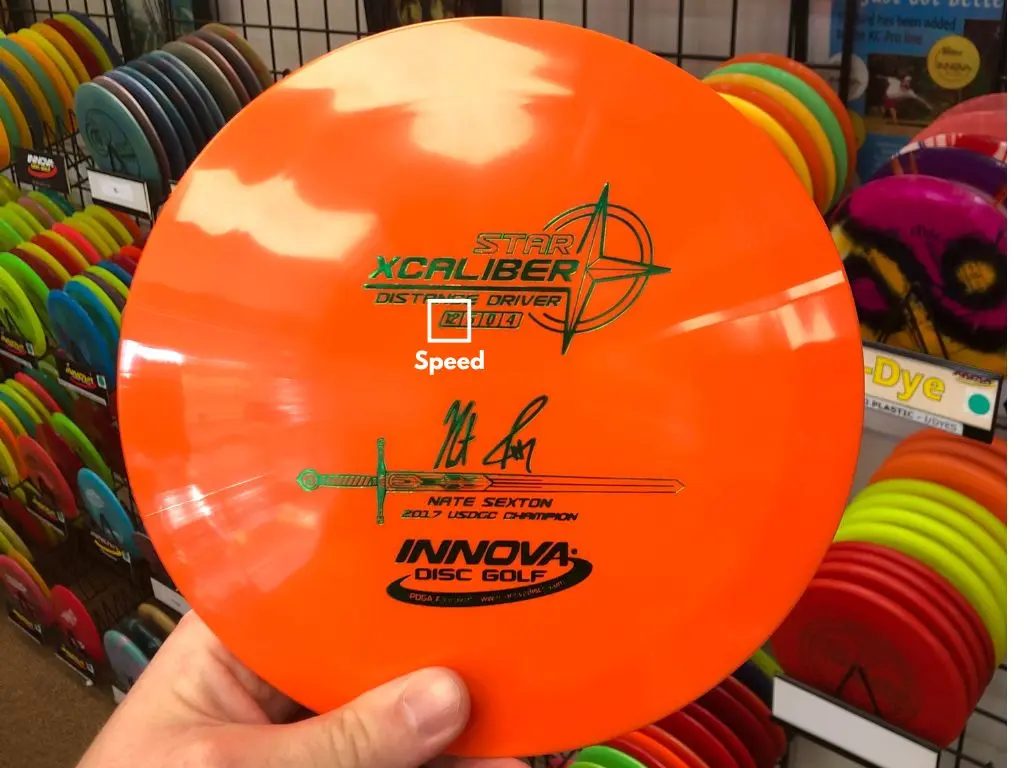Flight numbers are the first tool for players to learn how a new disc might fly, before even taking it off the shelf. This system, adopted by most brands, is designed to classify all the different discs and help disc golfers determine the best discs for them.
Typically, manufacturers will use four different numbers to describe the flight characteristics of the disc. The 1st number is speed, the 2nd number is glide, the 3rd number is turn, and the 4th number is fade. These are typically found on the top of the disc.
Here are the flight numbers of the Innova Xcaliber below:
Speed: 12 | Glide: 5 | Turn: 0 | Fade: 4 |
Do Flight Numbers Matter?
Flight numbers are highly important in developing a first impression of a disc and identifying what type of discs work for each individual disc golfer. They can help a player find discs that achieve new shot types that were previously difficult- they’re the identifier to find the right disc for each job.
Ultimately though, flight numbers are not always perfect. There are infinite factors that can affect the flight of a disc: from player ability to plastic type or weight; sometimes the flight numbers are not what they seem. Visit us at Disc Golf Mart for personalized advice and insights to select the perfect discs for your play. From beginners to pros, we’re happy to help out.
Let’s dive deeper into the numbers: Speed, Glide, Turn, and Fade, and how they translate to on-course performance.

Speed
Speed is the potential velocity of the disc. Speed ratings, which are between 1 and 15, can help determine the relative distance the disc is designed to travel.
Low speed discs, between 1 and 3, are used for shorter throws and putting. Midrange discs, between 4 and 6, are used for more controlled throws. For many beginners, it may be easier to learn with more midranges, as they will be more controllable.Discs between 6 and 10 are called fairway drivers. They are meant for throwing further distances with more accuracy and control.
High speed discs, between 10 and 15, are meant to travel further. However, many beginner players may struggle to throw these discs as they can not yet generate the power and spin required to achieve the maximum flight. For more experienced disc golfers, these disc will allow them to generate the most distance in their throws..
Glide
Glide describes how much loft the disc can maintain during its flight. Higher glide discs can stay in the air longer and travel further, whereas lower glide discs can punch through the air quickly and accurately.
Discs with more glide are great for long distance throws, however they may struggle with the wind. In the wind, discs with less glide will excel.


Turn
Turn describes the initial direction of the disc, whereas fade describes how the disc will finish its flight. As seen with the graphic, which depicts the full flight shape of a right handed backhand throw, a disc will turn before it fades.
Discs with higher turn numbers will have a more exaggerated turn, whereas discs with lower turn numbers may have a more gradual and less noticeable initial turn. Discs with more turn are oftentimes friendlier to beginners, as they will allow newer players to achieve longer distance throws more easily. For a right handed backhand throw, the turn will be to the right. For a left handed backhand throw, the turn will be to the left.

Fade
Discs with higher fade numbers will have a more exaggerated end of flight, finishing more aggressively. These discs are good for throwing reliably in the wind and generating more consistent accuracy. For a right handed backhand throw, the fade will finish to the left. For a left handed backhand throw, the fade will finish to the right.
Discs with lower turn and fade numbers will generally fly straighter, with minimal movement to the right and left when thrown optimally.

Stable vs. Understandable
When learning about flight numbers, the terms stable and understandable may emerge and can enhance a beginner’s understanding. A disc’s stability is closely tied with its turn and fade flight numbers.
A stable disc will have a turn value closer to 0 and a fade value closer between 1 and above. With appropriate power, they will fly straight before having a strong finish. These discs are consistent and predictable.
An understable disc will have a negative turn value. The lower the number, the more aggressive the turn will be. These discs are excellent for navigating obstacles and enabling more distance for players with less powerful throws.
Beyond the Numbers
Grasping these flight numbers transforms your game from a simple disc throw to a strategic sport. Each shot, whether to recover from a tough spot or to make a play closer to the basket, becomes a decision-making process where your understanding of each disc’s flight characteristics comes into play. It’s not just about the discs that veer left or right, it’s about choosing them for their abilities to fulfill the demands of specific situations on the course that are specific to your game and how you throw.
Visit us at Disc Golf Mart for personalized advice and insights into selecting the perfect discs for your playing style. Whether you’re aiming to refine your technique or just starting out, our experts are here to guide you through the fascinating world of disc golf flight numbers, ensuring every disc in your bag serves a purpose towards improving your game.

